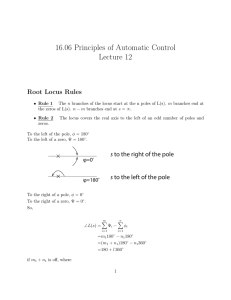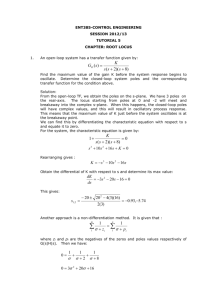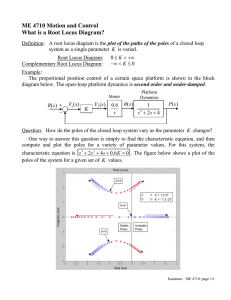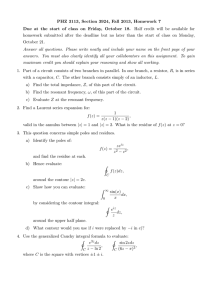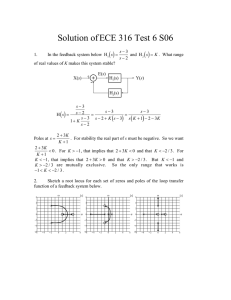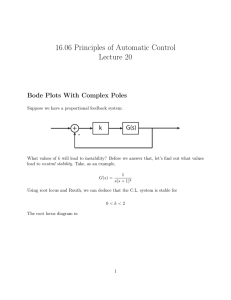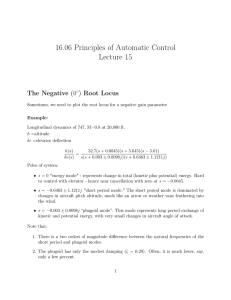Locus 6 More Root
advertisement
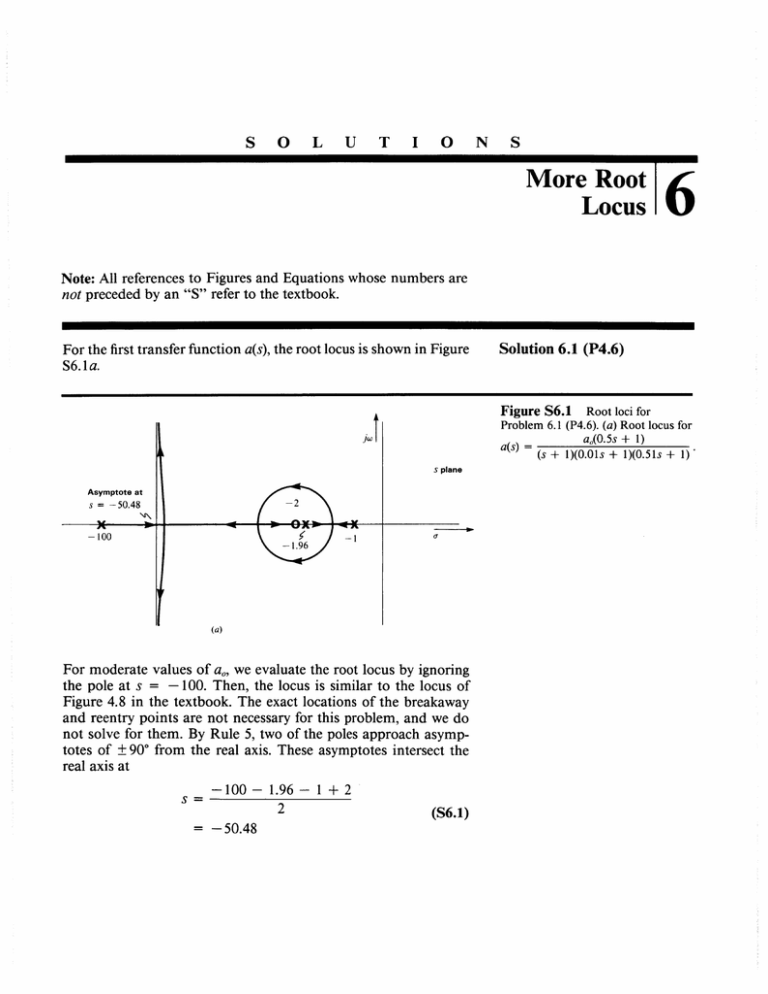
S
0
L
U
T
I
0
N
S
More Root
Locus 6
Note: All references to Figures and Equations whose numbers are
not preceded by an "S"refer to the textbook.
For the first transfer function a(s), the root locus is shown in Figure
S6.1a.
Solution 6.1 (P4.6)
Figure S6.1
.i
S plane
Asymptote at
s = -- 50.48
-100
(a)
For moderate values of ao, we evaluate the root locus by ignoring
the pole at s = - 100. Then, the locus is similar to the locus of
Figure 4.8 in the textbook. The exact locations of the breakaway
and reentry points are not necessary for this problem, and we do
not solve for them. By Rule 5, two of the poles approach asymp­
totes of ± 90* from the real axis. These asymptotes intersect the
real axis at
-100
= -50.48
- 1.96 - 1 + 2
2
Root loci for
Problem 6.1 (P4.6). (a) Root locus for
a,(0.5s + 1)
a(s) =
(s + 1)(O.Ols + 1)(0.51s + 1)'
(S6.1)
S6-2
Electronic Feedback Systems
Considering that the third pole is moving to the right towards the
zero at s = -2, the two poles must break away slightly to the right
of the asymptotes, in order to satisfy Rule 4.
For the second transfer function a'(s), the root locus is shown
in Figure S6.1b.
Figure S6.1
a's) -
(b) Root locus for
aa,(O.51s
+ 1)
(s + 1)(O.Ols + 1)(0.5s + 1)'
jl
Asymptote at
s = -50.52
-100
s plane
-2
-1.96
- I
o­
(b)
By Rule 5, two of the poles will approach asymptotes of ± 90"from
the real axis. These asymptotes intersect the real axis at
-100
- 2 - 1 + 1.96
= -50.52
2
(S6.2)
Because the third pole is moving to the left towards the zero at s
= - 1.96, the two poles must break away from the real axis slightly
to the left of the asymptotes, in order to satisfy Rule 4.
The root locus for the third transfer function a"(s) is shown in
Figure S6.lc.
More Root Locus
Figure S6.1
(c) Root locus for
a"(s) =(s + 1)(0.O1s + 1)'
1w
Asymptote at
s = -50.50
1'
S plane
-1
-100
F
(c)
Again, the asymptotes are at ± 900, and intersect the real axis at
S=
-100-
1
= -50.50
(S6.3)
To satisfy Rule 4, the poles break away from the axis exactly on
the asymptotes.
Inspection of the three root-locus diagrams indicates that the
three systems will have very similar behavior for moderate to large
values of ao. This is true because the complex pairs approach
nearly identical asymptotes in all three cases. Further, the low-fre­
quency pole-zero doublets effectively cancel out. Thus, intuition is
verified by the root-locus behavior.
S6-3
S6-4
ElectronicFeedbackSystems
M
Solution 6.2 (P4.8)
Figure S6.2
_____
The unity-gain inverter connection is shown in Figure S6.2.
Unity-gain inverter.
R
R
The loop transmission for this connection is - %/2a(s).Thus the
characteristic equation of 1 minus the loop transmission is
1 + %a(s) = 0
(S6.4)
or, substituting in for a(s):
1+
5X104
(rs + 1)(10-6S + 1)
0
(S6.5)
104 = 0
(S6.6)
Clearing fractions and multiplying terms gives
10-6s
2
+
(r
+ 10-6)s + 1
+ 5X
Following Equation 4.75 in the textbook, we make the associations
p'(s) = s(10-6s + 1)
(S6.7a)
q'(s) ~ 10- 6s + 5 X 104
(S6.7b)
and
Then, the root contour method indicates that we should form a
root locus with poles at the zeros of q'(s) and zeros at the zeros of
p'(s). Thus, we have a pole at s = -5 X 1010, and zeros at s = 0,
and s = -106. This configuration of singularities may seem
strange, because it represents a physically impossible system hav­
ing more zeros than poles in the finite s plane. Remember, how­
ever, that the zeros associated with the root contour technique are
not the closed-loop zeros for the system under study. (The invert­
ing connection in question here certainly doesn't have a zero at the
origin.) The root contour does, however, accurately represent the
location of the closed-loop poles as -ris varied.
More Root Locus
We construct the root contour by recognizing that there is a
pole at infinity that will move in from the left. Thus, the contour
is as shown in Figure S6.3.
Figure S6.3
Root contour for
Problem 6.2 (P4.8).
s plane
-5
r-%f
,
X 10'
- .'
a
circle centered
at -5
X 10'0
The angle condition imposes
branches circle the pole at -5
real axis at s = -5 X 10' is
the group of singularities near
the geometric constraint that the
X 1010. The entrance point on the
solved for by applying Rule 7 to
the origin (i.e., the zeros at s = 0
and s = - 106). That is, the breakaway point found by considering
only the zeros is at the point
S=
+ 0_
-106
2
= -5 X 105
(S6.8)
For some people (including the author of this solution), this root
contour will still seem contrary to common sense. What is perhaps
a more intuitive solution may be found by making the substitution
a = 1/r. Then, the characteristic equation (after clearing fractions)
is
s(10-6s + 1) + a(10- 6s
+ 5 X 104) = 0
(S6.9)
This root contour has poles where the contour of Figure S6.3 has
zeros and vice versa, which will look more natural to many read­
ers. The location of the contour is identical in both cases.
S6-5
S6-6
ElectronicFeedbackSystems
Returning to the contour of Figure S6.3, we solve for the value
of r required to set { = 0.707. In the vicinity of the origin, where
the closed-loop poles have a damping ratio of 0.707, the root con­
tour is well approximated by a vertical line through the point s =
-5 X 10', as shown in Figure S6.4.
Figure S6.4 Root contour for
Problem 6.2 (P4.8) in the vicinity of
the origin.
I1
j5 X
105
S plane
-5
x 10
a­
-j5 X 105
Poles on this contour with a damping ratio of 0.707 will be at s =
-5 X 105 ± j5 X 105 as shown. Then, Rule 8 is used to solve for
the value of rwhich will result in this damping ratio. From Equa­
tion 4.56, the required value is
More Root Locus S6- 7
q'(s)
Ip'(s)
5
s=-5x10 (1+j)
10- 6s + 5 X 104
s(10- 6s + 1)
(S6.10)
s=-5xios(+j)
=0.1
In closing, we note that this problem could be solved quite
directly by putting Equation S6.6 into the standard form
-
+
Wn
s + 1 = 0. Then, simply set i = 0.707, and solve for r. Such an
approach verifies the results we have obtained via the root contour.
MIT OpenCourseWare
http://ocw.mit.edu
RES.6-010 Electronic Feedback Systems
Spring 2013
For information about citing these materials or our Terms of Use, visit: http://ocw.mit.edu/terms.
